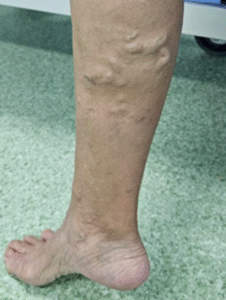Prof. Kittipan Rerkasem
Leg Vein Clinic Thailand
What Are Spider Veins?
Spider veins (Telangiectasia) are small, thin, superficial veins appearing red, purple, or blue—commonly seen on the thighs, legs, behind the knees, or around the ankles. They result from increased venous pressure causing dilation of small veins.
They are usually harmless but can be an early sign of venous disease.
What Are Varicose Veins?
Varicose veins are enlarged, bulging veins caused by **venous valve failure**. When valves fail, blood flows backward and pools, leading to swollen, twisted veins.


Image: Left image shows spider vein and right image shows varicose vein
Common symptoms include:
- Leg pain, tightness, heaviness
- Evening swelling
- Night cramps
- Skin darkening at the ankle
- Chronic venous ulcers in severe cases
Will Spider Veins Become Varicose Veins?
Yes—**they can**, but not always.
Some spider veins appear because major superficial veins (e.g., Great Saphenous Vein) have reflux. Untreated reflux increases pressure, causing spider veins to spread and eventually develop into varicose veins.
However, if spider veins occur only superficially without main-vein reflux, they may remain stable but still increase with age or lifestyle.
This is why **Duplex Ultrasound** is crucial to determine whether major vein reflux exists.
Risk Factors for Spider Veins Progressing to Varicose Veins
- Family history (2–3× higher risk)
- Female gender (estrogen weakens vein walls)
- Pregnancy
- Prolonged standing or sitting
- Obesity
- Aging
- Lack of exercise
What Should You Do When You Notice Spider Veins?
- Observe calmly
Monitor for increase in number or accompanying symptoms (pain, tightness, swelling).
- Get a Duplex Ultrasound
This identifies venous reflux early. Treating early prevents future varicose veins.
- Begin self-care
- Avoid standing >2 hours without moving
- Elevate legs when resting
- Walk regularly or exercise
- Weight control
- Wear compression stockings
Treatment Options for Spider Veins
- **Sclerotherapy**
Injection of a solution that seals and fades the spider veins.
Safe, effective, no surgery needed, and immediate return to normal activity.

Image shows picture before (left) and after sclerotherapy (right)
- **Laser Treatment**
Laser energy targets and closes very small or superficial veins. Often combined with sclerotherapy for best results.

Image show during cutaneous laser therapy
- **CLACS (Cryo-Laser and Cryo-Sclerotherapy)**
A modern technique combining laser + injection with cold air to reduce pain and improve results.
When Should You See a Doctor?
- Sudden increase in spider veins
- Pain, tightness, swelling, or skin darkening
- Presence of large varicose veins
- Recurrence after previous treatment
- Strong family history
Conclusion
Spider veins are not just cosmetic—they may be early warning signs of venous reflux. Early evaluation allows easier, more effective treatment and prevents future complications such as major varicose veins or ulcers.
“Spider veins are an early signal. If we listen early, we prevent future problems.”
— Prof. Kittipan Rerkasem, Vascular Surgeon
FAQ – Top 5 Questions
- Do spider veins go away on their own?
No. They typically require treatment.
- Do compression stockings help?
Yes. They reduce swelling and slow progression but it does not make spider vein or varicose vein disappear.
- Are spider veins related to heart disease?
No. They involve superficial leg veins, not the heart.
- Do treated spider veins come back?
They may, especially if risk factors persist. Regular follow-up helps prevent recurrence.
